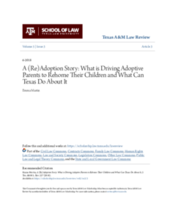ABSTRACT
Ava was adopted from Africa when she was four years old. She became the baby sister to two older brothers and the daughter to two loving, experienced parents. A year or two after Ava moved to America, she and her “forever family” attended a Colorado summer camp. All was seemingly well until the camp staff and the other families at camp started to notice something strange about the way Ava’s parents treated her compared to her brothers. After an activity, the parents greeted the brothers with an excited “did you have fun?” or “what did you learn?,” while the parents greeted Ava with a terse scolding for leaving her jacket behind. When the boys each sat next to a parent at the front of the boat on a white-water rafting trip, baby Ava sat at the very back of the raft next to a guide she did not know. These scenarios, along with others, raised questions and concerns.
Another family, who had several adopted children, reached out to Ava’s parents and asked how she was doing in her new home. Ava’s family admitted that Ava, though sweet and loving at times, was having behavioral issues that they believed were linked to a lack of attachment to the family. They also admitted that they just could not love her the way that they loved their biological children. In the end, Ava’s parents decided that they had had enough— they no longer desired Ava to be their daughter. They relinquished their parental rights and sent Ava to live with the family they connected with at summer camp. Ava’s new family formally re-adopted her and gave her the love and support she desperately needed. And at last, after three families and two adoptions, Ava finally found her “forever family.”
Unfortunately, this pattern is not altogether uncommon. Many parents who adopt children, especially older children, face similar stories of a frustrating inability to thrive as a family once the child enters the home. This pattern of adopting a child and then later seeking to find another home for that child has been coined “rehoming.” Rehoming is largely unregulated by most states and only minimally regulated in Texas. Fortunately for Ava, she found a true “forever family” who gave her a home she could thrive in. Some children are less fortunate. In fact, because of the regulatory void, some children are handed over to new parents without any vetting by an official agency. These practices are reckless and violate Texas’s policy to find homes that are in the best interest of children. For that reason, Texas must take action in both its child advocacy and its criminal laws to prevent and, when impossible to prevent, control rehoming practices.
This Comment will look first at the mechanics behind rehoming—what it is and where it fits into the legal framework of the child welfare system. Next, it will look at the causes of rehoming, focusing specifically on how trauma in a child’s background can create a need for specialized training techniques. Lastly, it will look at other states’ legislation to combat rehoming and suggest different areas where Texas can improve its child welfare laws to both prevent and deter rehoming.

